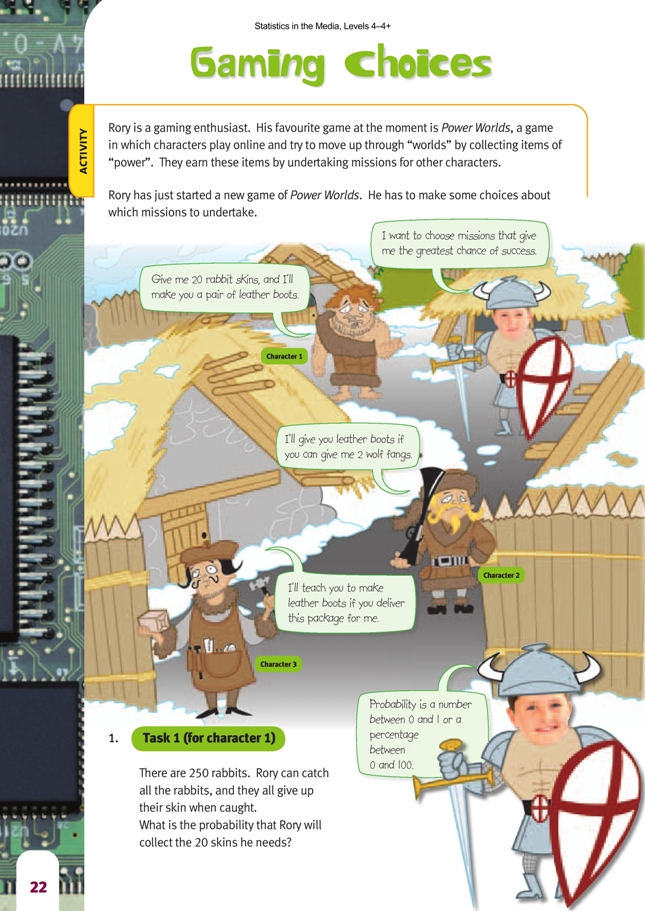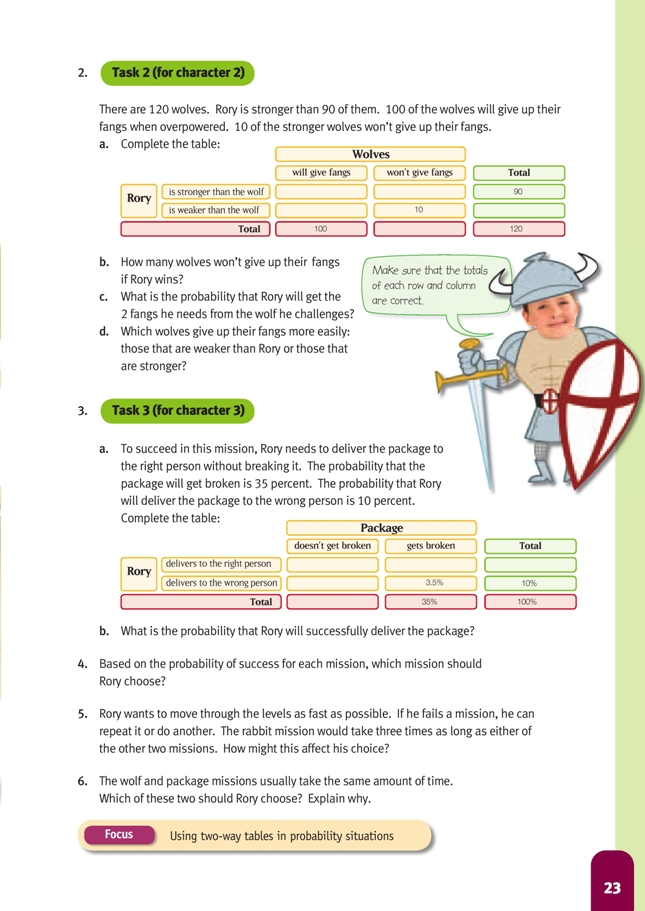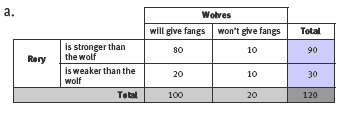This is a level 4 statistics activity from the Figure It Out series.
A PDF of the student activity is included.
Click on the image to enlarge it. Click again to close. Download PDF (1239 KB)
use tables to explore probabilities
This diagram shows the areas of Statistics involved in this activity.
The bottom half of the diagram represents the 5 stages of the PPDAC (Problem, Plan, Data, Analysis, Conclusion) statistics investigation cycle.
Statistical Ideas
Gaming Choices involves probability and two-way tables.
Many students will be very familiar with computer gaming, particularly strategy games. Strategy games typically involve completing missions to get to the next level. There is always a probability factor involved. In this activity, the students explore probability in a gaming context. The first task is straightforward, but the other tasks involve two-way tables.
Two-way tables are usually of this form:
(Note that A1 is the set of all things that are not in the set A.) Two-way tables summarise two events (for example, a coin toss and a dice roll). They can be used to answer probability questions such as “What is the expected number of times you would get both heads and a 6 from 600 rolls and tosses?” The two-way table
can be started by filling in the expected number of 6s (100 out of 600) and the expected number of heads (300 out of 600).
From here, it is a matter of keeping totals correct to fill the gaps and find an answer of 50 (see the shaded box):
You can then turn these into percentages. 50/600 chances of getting both a 6 and heads is 8.333%.
It’s a characteristic of computer gaming that there’s a probability built into every “mission”. The “10” provided in the two-way table in Task 2 for stronger wolves who won’t give up their fangs and the “35%” in Task 3 of missions where the package gets broken are factors that are built into the game. The students use
these factors to complete the tables in a logical way and then make deductions from them.
Task 1 in Gaming Choices is an opportunity to look at certainty as a probability concept. If something is certain, the probability is 1 or 100%. Task 2 requires students to complete and then “read” the two-way table. To answer question 2b, they need to locate the cell that means Rory is successful. That is, they need to
connect “Rory will win” with “Wolves will give fangs” – this is the top left cell. You may wish to discuss with the class what the other cells represent. All numbers will come from cells in the two-way table. For the wolves weaker than Rory, 80 out of a total of 90 weaker wolves will give up their fangs; similarly, 20 out of a total of
30 stronger wolves will give up their fangs.
Task 3 is very similar to the above, but this time, percentages are given.
Questions 4, 5, and 6 are about using probability to help with decision making. Note that a high probability does not guarantee success; for example, a 90% chance of rain may still result in a sunny day!
Extension
Do a class brainstorm of the other games that use probability and discuss ways of calculating probabilities from known information.
Answers to Activity
1. 1 (or 100%)
2.
b. 10
c. For Rory to get the 2 fangs, he needs to overpower the wolf (so he has to be stronger) and the wolf has to give up his fangs. This is the top left box. 80/120= 67%.
d. 80 of the 90 wolves that are weaker than Rory will give up their fangs; 80/90 = 89%. 20 of the 30 wolves that are stronger than Rory will give up their fangs
(20/30 = 67%) if they are defeated. So those that are weaker than Rory give up their fangs more easily.
3.
b. 58.5%
4. The rabbit mission because he has 100% chance of succeeding. (He has a 67% chance of succeeding in the wolf mission and a 58.5% chance in the package mission.)
5. There is no simple answer to this question. The only mission that Rory can be sure to succeed with first time is the rabbit mission. But if speed really matters, Rory
should probably try the wolf mission (see the answer to question 6) because if he succeeds on the first or second attempt, he will have saved time. And even if it takes him 3 attempts before he succeeds, his decision won’t have actually cost him time.
6. Based on time, Rory should choose the wolf mission because the probability of success is 67%, which is higher than the 58.5% for the package mission.
Key Competencies
Gaming Choices can be used to develop these key competencies:
• thinking: making deductions, dealing with uncertainty, and making decisions
• using language, symbols, and texts: interpreting statistical information and interpreting word problems.







